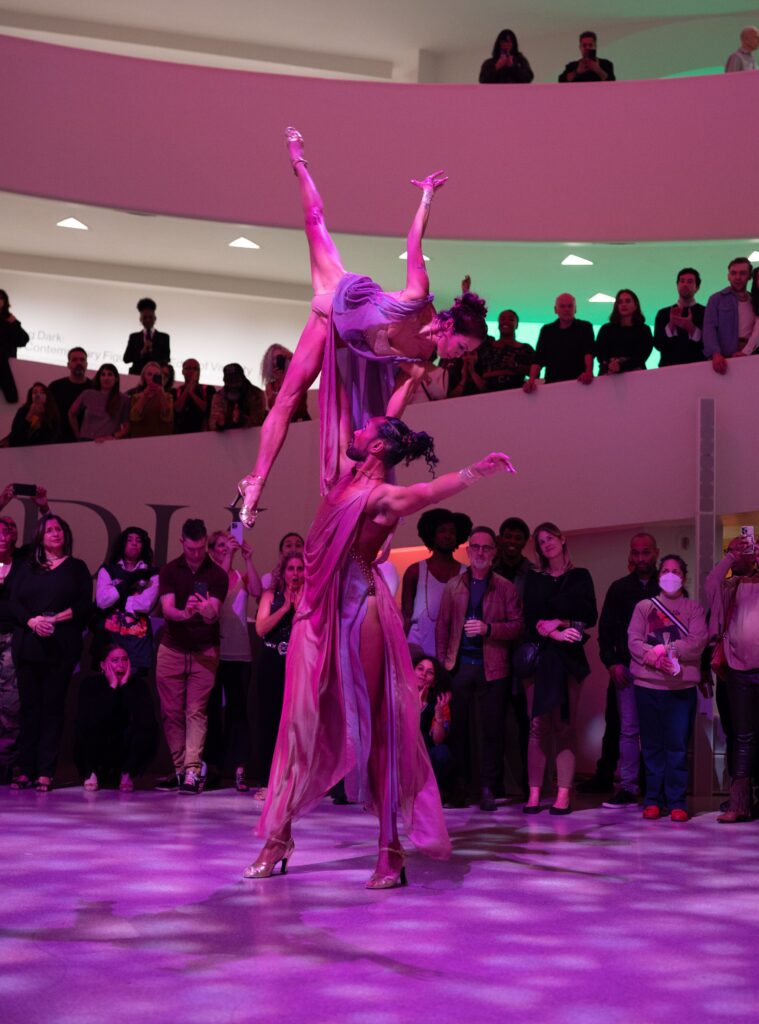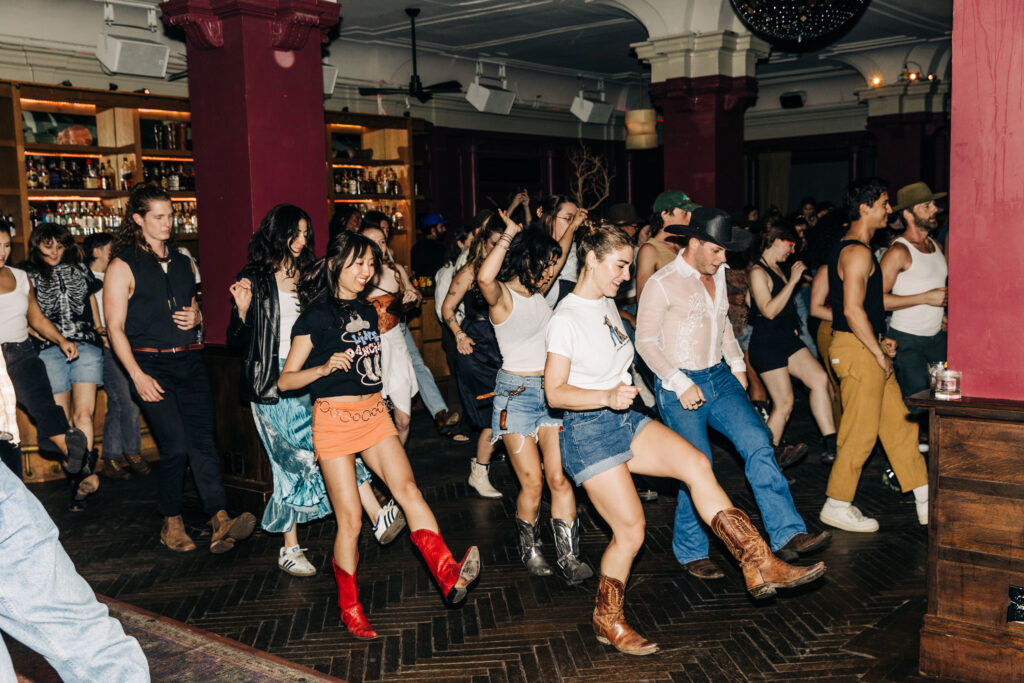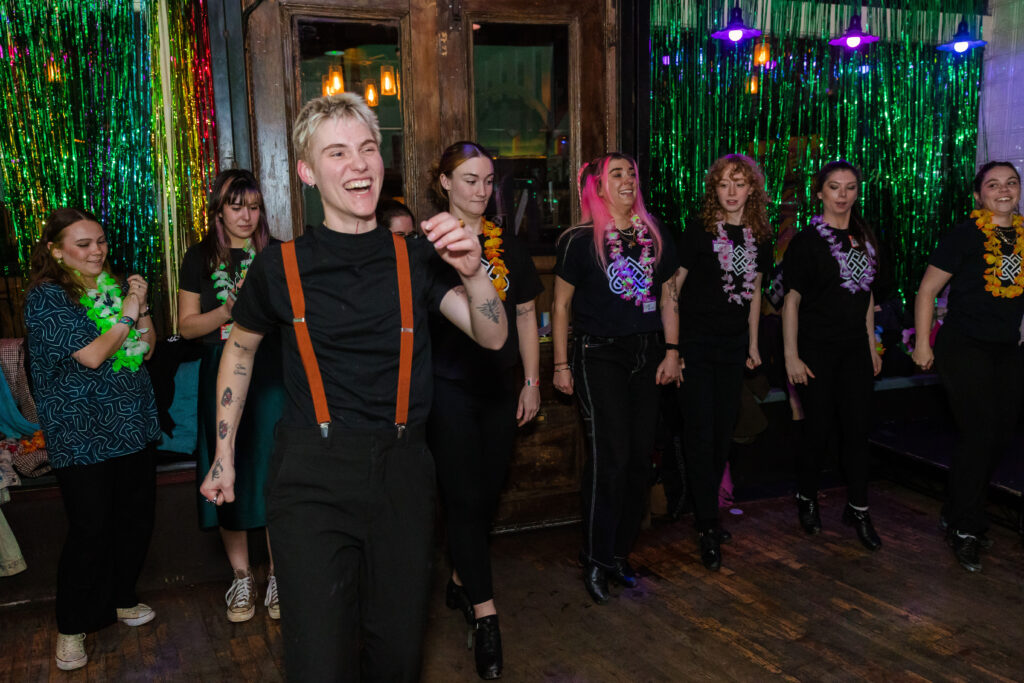The Rise of Queer-Friendly Social Dances
On any given night across the country, queer people can be found dancing hand in hand, arm in arm, cheek to cheek in bars, bowling alleys, and convention centers. From line dance classes to salsa parties to Irish dance céilís, social dance culture is becoming increasingly queer-friendly, often flipping the script on the strict gender binary these genres have traditionally upheld. And while the recent surge in LGBTQ+ social dance is undeniable, so too are the progressive—and, in some cases, queer—roots of many of these dance styles.
Hidden Histories
Traditional social dances have historically relied on a cisgendered male “leader” and female “follower.” But certain social dance genres have always accommodated gender-neutral partnering.
“Lindy Hop, for example, has been a progressive dance form since the beginning,” says dancer and choreographer Caleb Teicher. “It was started by young Black people in Harlem, and was revolutionary for its time. Al Minns and Leon James were two men who regularly performed Lindy Hop together in movies and on television, and no one questioned the appropriateness of them dancing with one another.” Hustle and line dancing were also embraced by queer communities in New York City in the 1970s and San Francisco in the 1980s.
But the queer histories of these dances have been largely eclipsed by heteronormative representations in pop culture. Abdiel Jacobsen, known professionally as Abdiel—a former principal dancer with the Martha Graham Dance Company and a community organizer dedicated to the cultural preservation of hustle—says the 1977 movie Saturday Night Fever marked a turning point in hustle’s history. “The movie centers around a white, straight, cisgendered man’s experience in club culture and nightlife,” Abdiel says, “but what is portrayed is the antithesis of the freedom and community that hustle is about.”

(Literally) Making the Space
Today, dancers are dismantling the norms of traditionally gendered social dances. “In a lot of the larger cities in America, it’s just a relatively safer time to be out and proud, so people are seeking out spaces where it feels safe to dance with who they want to dance with, or identify how they want to identify,” Teicher says. “Of course, there are a lot of places and circumstances where it’s not safer”—making the cultivation of LGBTQ+-friendly dance spaces even more important.
Motivated by the desire for these spaces, queer people have begun dreaming up their own social dance utopias. Stud Country, which was “born from the legacy of queer dance spaces and honors the rich history of LGBTQ cowboy culture,” hosts weekly line dance lessons and monthly parties in Los Angeles, San Francisco, and New York City, and has exploded in popularity since its founding in 2021. “We wanted to create a place where people can meet up, but it’s not preordained—there’s no guest list,” says co-founder Sean Monaghan. “You just show up and dance.”


Angelica Medina, who co-founded the Queer Afro Latin Dance Festival in 2018 with her wife and dance partner Jahaira Fajardo, reflects on how her own upbringing informed the festival’s gender-neutral structure. “I didn’t grow up seeing two women or two men dancing together, so I didn’t feel like I had the permission to explore that,” she says. In addition to gender-neutral partnering, the festival’s programming includes panels on consent, queer movie screenings, and evening socials for queer elders who might not want to dance until midnight.
Even in social dance scenes that aren’t explicitly queer, some organizers have committed to creating environments where everyone feels recognized. “In swing class pedagogy, some classes now follow the ELEF structure—everybody leads, everybody follows,” Teicher explains. “In the context of gender-expansive ideology, the idea that these roles are malleable can be really meaningful.”

A Constant Evolution
Queer social dance is here for the long run. “People have begun reclaiming this art form, and no longer have to shrink themselves in order to participate,” says Fajardo. But a sense of urgency permeates these spaces, too.
“Queer culture can be really cynical and lead to so much bodily shame and isolation,” Monaghan says, “but partner dancing provides this incredible platonic intimacy. With Stud Country, I want to create the world that I want to grow into.”
Abdiel agrees, and stresses the vulnerability inherent in these genres. “You consent to being touched and moved throughout a space, so there’s a lot of care and empathy that goes into it,” they say. “But there is always room for more empathy as we continue approaching and evolving this practice.”
Generational Groundwork
When Alexandra Owensby, co-founder of Brooklyn Irish Dance Company, initially dreamed up Gayli—a queer-friendly céilí (social dance gathering) at Mary’s Bar in Brooklyn, New York—she didn’t anticipate just how healing the event would be for LGBTQ+ people who studied Irish dance growing up. “We’ve received comments about how Gayli lets them reclaim this thing they loved as a kid, but that ultimately became very suffocating for them,” Owensby says. “To be able to provide this space for people as their authentic, adult selves has been a blessing.”

Fellow BIDC co-founder Erin O’Donnell has also been teaching Irish dance to kids in Brooklyn for 10 years, and credits them with helping her move past some of the genre’s traditional partnering terms (“lady” and “gent”) and costuming expectations (skirts for the girls and pants for the boys). “Kids love to repeatedly ask ‘But why?’ and when you’re asked that question enough times, you’re finally like, ‘Maybe it doesn’t need to be a rule anymore,’ ” she says.
O’Donnell’s experiences as a teacher have imbued her with a new sense of responsibility. “We’re raising the next generation of dancers, some of whom come out at a young age,” she says. “We need to ensure that the studio is a safe space for them, since the broader dance community might not be as accepting.”
A Vital Community
Though Janaye Pohl doesn’t have a traditional dance background, they’d performed choreographed routines with their high school’s marching band and drumline. They found a special kind of affirmation and acceptance, and a reignited passion for performance, at Stud Country, which they attended for the first time in May 2023. Pohl has become a fixture at the event’s San Francisco party, demonstrating dances onstage.
“As a nonbinary queer person, I feel a lot of relief around not having to conform to a role based on how others perceive me,” Pohl says. “The ritual of asking the question ‘Lead or follow?’ is empowering, and I can’t imagine dancing in a space where it’s assumed I’ll take a certain role based on gender.”
Pohl also recognizes how queer social dance spaces can help build lasting community—and acknowledges the queer country-and-western dance pioneers who laid the groundwork for today’s scene. “In San Francisco, we’re lucky to have great examples of established communities like the Sundance Saloon, which has been around for 26 years, or Starlight Strut, which is specifically for women, trans, and nonbinary queer folks,” they say. “I feel optimistic that these types of social dance spaces are actually creating more of what folks are seeking, which is real-life connection and community versus just a place to drink or party.”





